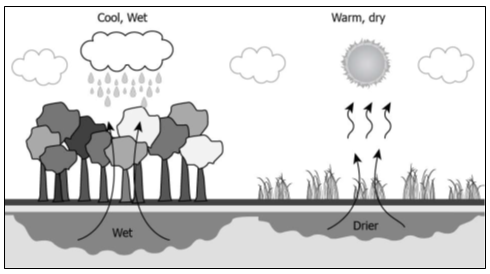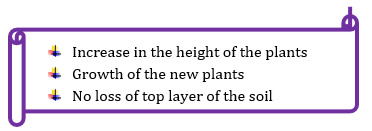Conservation Of Plants And Animals Worksheet
Objective Type Questions
- Fill in the blanks with suitable words.
(a) ………………… is the conversion of fertile land into deserts.
(b) A group of population which are capable of interbreeding is called a …………………
(c) ………………… was launched by the Government to protect the tigers in the country.
(d) ………………… is the restocking of destroyed forests by planting new trees. - Match the terms in column A with appropriate terms in column B.
- Classify the below animals as endangered, extinct, or endemic species.
Multiple Choice Questions - Several factories are built by cutting down trees and clearing of forests. What will be its likely effect on the nature?
(a) decrease in the number of wildlife
(b) sudden boost in the plant growth
(c) availability of more food for wildlife
(d) increase in the percentage of land occupied with trees - The below chart lists some events.
Which of these events will lead to deforestation?
(a) A and C
(b) A and D
(c) B and D
(d) C and D - The image shows the effect of deforestation on water cycle. What is likely to happen if deforestation continues?
(a) Increase in oxygen level
(b) Decrease in temperature
(c) Increase in annual rainfall
(d) Decrease in the level of groundwater - Bori Sanctuary and Satpura National Park are present in the Pachmarhi Biosphere Reserve. How do these three areas help in protecting the plants and animals?
(a) These large areas provide artificial habitat to wildlife.
(b) These large areas conserve organisms and their habitats.
(c) These large areas control the number of wildlife by preventing natural breeding.
(d) These large areas prevent the interaction of organisms with wildlife to keep them safe. - Kailash went on a trip to a biosphere reserve called Panna in Madhya Pradesh and Keoladeo National Park in Rajasthan. Which common activity is likely to be observed in both the protective areas?
(a) They provide protective environment to the fauna only.
(b) They provide shelter to humans as well as wildlife.
(c) They allow human activities for interaction with the wild animals.
(d) They do not interfere with the natural environment of the wildlife. - The image shows some plants of a particular area. Which term can be commonly used for all the plants?
(a) Flora
(b) Fauna
(c) Wild trees
(d) Aquatic plants - Species of deer are commonly distributed in the states of northern and central India. However, brow-antlered deer also called Sangai is found only in Keibul Lamjao Natural Park situated in Manipur. What could be the reason for this?
(a) Sangai is a native species.
(b) Sangai is an exotic species.
(c) Sangai is an endemic species.
(d) Sangai is a diverse species. - In a school, class 7 students went to a trip to Arunachal Pradesh while class 8 students went on a trip to Meghalaya. They observed different plants on these trips as shown.
What is the likely reason that class 7 and class 8 students did not observe the same plants at different locations?
(a) Both the plant species show migration
(b) Both the plant species are exclusively found in a particular habitat
(c) Both the plant species depend on different types of herbivorous animals
(d) Both the plant species depend on different components for preparing food - Jim Corbett National Park of India protects the endangered Bengal tiger. What likely measure have they adopted to protect this species of tiger?
(a) Controlled hunting of Bengal tiger
(b) Capturing tiger in a small area for better observation
(c) Increase the count of tigers by different methods of breeding
(d) Bring prey animals from neighbouring regions to increase the tiger count - What information is likely to be obtained from the Red Data Book?
(a) Record of all endangered species
(b) Information of all endemic species
(c) Categorisation of plants and animals according to species
(d) Information of all plant and animal species in the country - Which of the following is likely to reduce deforestation?
(a) Limiting the use of paper
(b) Using only fine quality paper for work
(c) Throwing old newspapers in dustbins
(d) Burying used and wastepaper instead of burning it - A group of students decided to grow new plants on a barren land. They planted the saplings, added manure to the soil and watered the plants daily. After three months, the students observed the following changes:
What can be concluded from these observations?
(a) Reforestation promotes soil erosion.
(b) Reforestation allows growth of the plants.
(c) Reforestation increases the amount of soil.
(d) Reforestation helps reduce the impact of deforestation.
Subjective Questions - How is decrease in the number of trees linked with the shortage of water?
- Regions with more trees experience less soil erosion. How do trees help to reduce soil erosion?
- The given chart lists some organisms. Classify them into flora and fauna respectively.
- Why are you advised to sell old newspapers and books to the Kabadiwala?
Case-Based Questions - Nisha set up an experiment to study the effect of deforestation. She collected soil from a forest area with trees and from a barren land with no trees. She added soil from the forest area in Pot 1 and soil from the barren land in Pot 2. She planted a hibiscus plant in both the pots. After 1 month, Nisha observed both the pots for the growth of the plant.
a) What would be Nisha’s observation?
(a) Plant in pot A shows good growth while plant in pot B shows minimal growth.
(b) Plant in pot B shows good growth while plant in pot A shows minimal growth.
(c) Plants in both pots A and B show good growth.
(d) Plants in both pots A and B show minimal growth.
b) What is the likely reason for this observation?
(a) Soil from barren land is less fertile.
(b) Soil from forested land is poor in nutrients.
(c) Soil from barren land contains more manure.
(d) Soil from forested land contains stored food for better plant growth.
c) Which one of the following changes may occur due to desertification?
(a) Decrease in atmospheric temperature
(b) Increase in water holding capacity of soil
(c) Increased chances of floods
(d) Conversion of fertile land into a desert - There are approximately 2500-3000 Ganges River dolphins left living in the wild. This means that the species is vulnerable and is categorised as endangered. The table shows an example of the different types of threat for the Gangetic Dolphin.
a) Surface runoffs containing pesticides also threaten the survival of the Gangetic Dolphin. As per the above table, to which type does this threat belong? Explain your answer.
b) Which of the following correctly defines an endangered species?
(a) Species which no longer exists
(b) Species whose numbers are diminishing to a level that they might face extinction
(c) Species found exclusively in a particular area
(d) Species which are vulnerable to endangerment shortly
c) Which of the following can be classified as an endangered species?
(a) Asiatic lion
(b) Dodo
(c) Dinosaur
(d) Tasmanian tiger
Assertion-Reasoning Questions
Below questions consist of two statements – Assertion (A) and Reason (R). Answer these questions selecting the appropriate option given below: - Assertion (A): Biosphere reserves, national parks and wildlife sanctuaries are the protected areas for plants and animals.
Reason (R): Above areas have different nature and habitat. - Assertion (A): Flying squirrel is an example of endemic fauna.
Reason (R): Endemic species are those species that are on the verge of extinction.
Explore more Science Sample papers and Solutions
-
Crop Production And Management Worksheet
- Microorganisms: Friend And Foe Worksheet
- Coal And Petroleum Worksheet
- Combustion And Flame Worksheet
- Reproduction In Animals Worksheet
- Reaching the Age of Adolescence Worksheet
- Force And Pressure Worksheet
- Friction Worksheet
- Sound Worksheet
- Chemical Effects of Electric Current Worksheet
- Some Natural Phenomena Worksheet
- Light Worksheet
- Competency Based Questions for CBSE Class 8 Science
Key Features of CBSE Class 8 Science:
- Prepared by subject matter experts
- According to the latest CBSE syllabus
- Helpful when doing homework
- Easy to understand
- Helpful for quick revision
- Score more marks in the examination
- Free textbook solutions & doubt-solving sessions
- Increase paper-solving speed
- Improvement in marks











